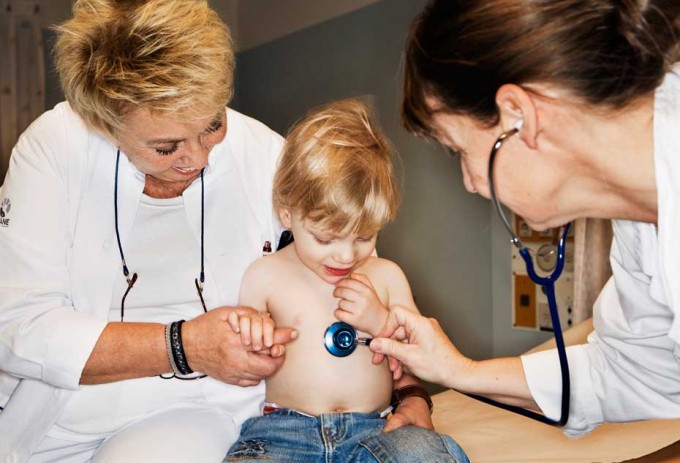
The Swedish health system is a socially responsible system with a public commitment to ensure the health of all citizens. Quality healthcare for all is a cornerstone of the Swedish welfare state.
The overall national objective of public health policy is to create conditions in society enabling the entire population to enjoy good health on equal terms. The objective of health and medical care policy is to offer the population needs-adjusted, accessible and effective care of high quality.
Three basic principles are intended to apply to healthcare in Sweden
- The principle of equal worth
All human beings have an equal entitlement to dignity and should have the same rights, regardless of their status in the Community. - The principle of need and solidarity
Those in greatest need are given precedence in medical care - The principle of cost-effectiveness
When a choice has to be made between different treatment options, there should be a reasonable relationship between the costs and the effects, measured in terms of health outcomes and quality of life.

Organization of health care in Sweden:
In Sweden, responsibility for health and medical care is shared by the central government, county councils and municipalities and is regulated under the Health and Medical Services Act.
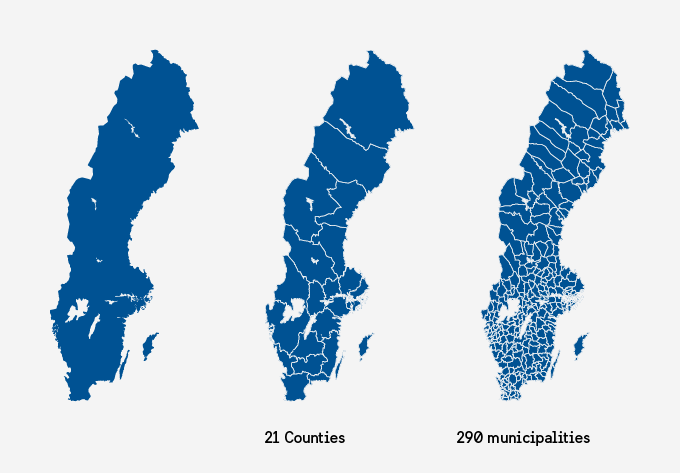
Sweden’s healthcare is divided into three administrative levels. All levels have democratically elected legislatures and both county councils and municipalities have tax collection powers.
1) The role of the central government is to establish principles and guidelines, and to set the political agenda for health and medical care. It does this through laws and ordinances or by reaching agreements with the Swedish Association of Local Authorities and Regions (SALAR), which represents the county councils and municipalities. There are eight government agencies directly involved in the area of health, medical care and public health.
2) The 21 county councils / regions are responsible for healthcare services to all residents
3) The 290 municipalities are responsible for care of the elderly in their home or in special accommodation. Their remit also includes care for people with physical disabilities and psychological disorders. Municipalities are also responsible for providing support and services for people released from hospital care as well as for school healthcare.
It is a strongly decentralized system, in which both county councils and municipalities have considerable autonomy and scope to formulate their operations
The Swedish Association of Local Authorities and Regions (SALAR) represents the government, professional and employer-related interests of Sweden’s municipalities, county councils and regions. In the area of health, the Association conducts for instance patient surveys and regional comparisons on health care quality and efficiency. One purpose of the regional comparisons is to inform and stimulate the public debate on healthcare quality and efficiency. A second purpose is to stimulate and support local and regional efforts to improve healthcare services, both in terms of clinical quality and medical outcomes, and in terms of patient experience and efficient use of resources.
Divisions of health and medical care
Primary care
Health centers provide the basis of health and medical care (approx. 1,200 health centers of which about 40% are private).
County medical care
When more specialized care is necessary, the county medical service/county hospital steps in (approx. 70 county hospitals).
Regional medical care
Regional/university hospitals manage rare and complicated diseases and injuries (seven regional hospitals).
National highly specialized care
Centralization of most specialized treatments. Requires approval from the National Board of Health and Welfare.
The Swedish care chain
The first contact with the health system often takes the form of a phone or online contact with the non-emergency medical on-call service. This on-call service, which can be contacted 24/7, has been available nationwide since 2013 and is staffed by nurses. The aim is that people who call will be given care advice or be helped to identify the correct part of the health and medical care system to approach. There are also now a number of interesting IT solutions that facilitate contacts between patients and health care providers.
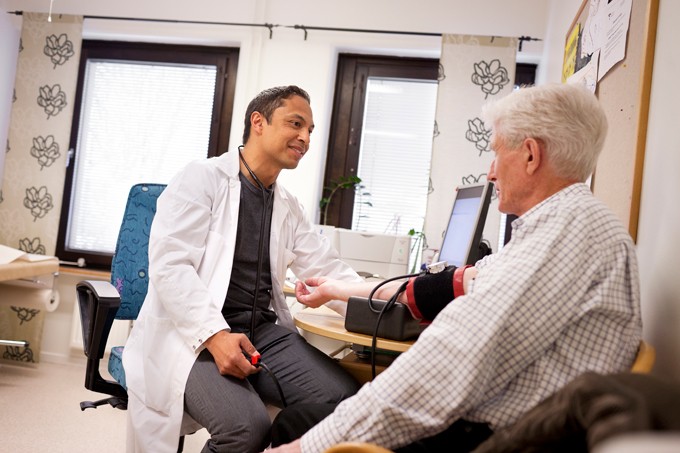
Primary care health centers are the basis of the Swedish health system and handle those patients who do not require the technical and medical resources of hospitals, providing treatment, rehabilitation, care and preventative care. Patients with chronic diseases, such as diabetes, visit the health center for regular check-ups. The doctor at the health center usually makes the initial diagnosis of more serious conditions, referring the patient to specialist care if the health center is unable to provide treatment or diagnosis. Many interventions that used to require the patient to be admitted to hospital can now be carried out within the outpatient care system at hospitals. This is considerably more cost-effective and also reduces the risk of hospital-acquired infections.
Sweden has about 70 hospitals that provide specialist care, of which 60 have emergency services available 24/7. Seven of these regional hospitals are university hospitals, where highly specialized care is offered and most teaching and research is based.
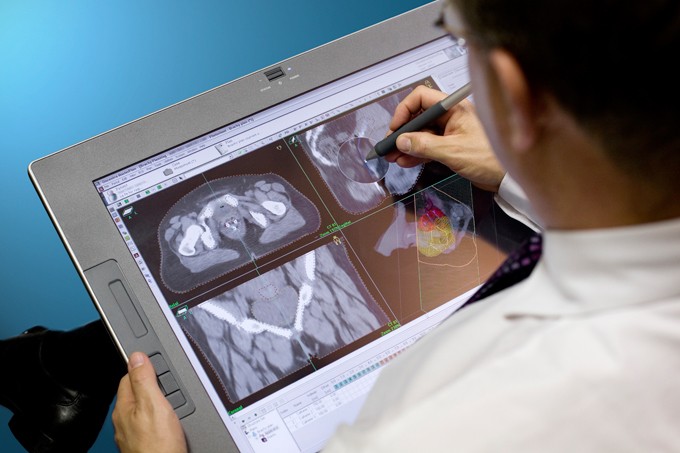
Six healthcare regions for highly specialized care
The Swedish county councils collaborate in regions for highly specialized care as many of them have small catchment areas. The regional health and medical care is responsible for particularly complicated diagnoses, rare diseases or injuries. This type of medical care is provided by seven regional hospitals – the university hospitals.
National highly specialized care
Treatment for the most complicated medical conditions of all, such as pediatric cardiovascular surgery, severe burns, transplant surgery, etc. are centralized to 1 or 2 university hospitals. The national highly specialized care is coordinated at central level by the National Board of Health and Welfare.

The municipalities
The municipalities are responsible for the care of the elderly. Care is governed by the Swedish Social Services Act and, to some extent, by the Swedish Health & Medical Services Act. Many of the elderly prefer to continue living in their own homes for as long as possible and a wide range of options are now available, enabling them to do this with the support of society and by making various adaptations to their home. Special residential accommodation for elderly and people with disabilities is available for those with extensive care requirements. To be offered a place in such specialized housing, a person must have substantial medical and/or social care requirements.
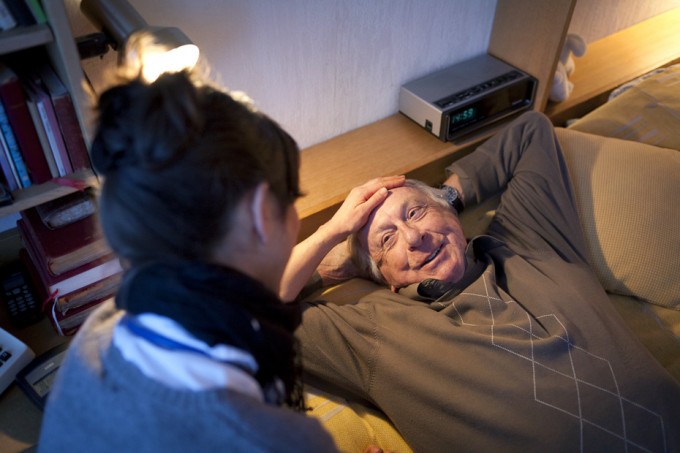
There are a large number of private care providers in the primary care and support sectors, and they are usually financed through the public system.
The counties own all the emergency hospitals, but healthcare services can be outsourced to contractors. There are a large number of private care providers in the primary care and support sector, and they are usually financed through the public system. The patient can choose their preferred health center, and pays the same amount regardless if the center is private or public . The majority of private care providers consequently has agreements with the county councils and receives the same remuneration as the public care providers. Completely private solutions, where the patient pays out of their own pocket for health or medical care, are very unusual in Sweden.
Healthcare resources in Sweden
The cost of health and medical care in Sweden is largely borne by county council and municipal taxes, with some funding also coming from the State. Specialized somatic care represents nearly 50% of the expenditure.
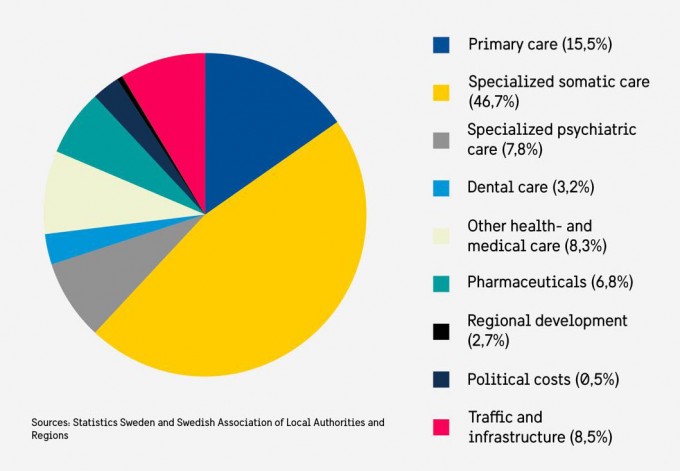
Health care resources: Expenditure county councils (2014)
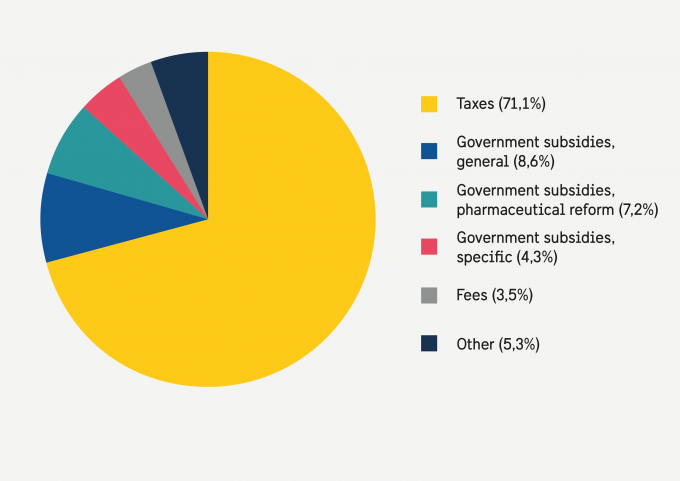
Health care resources: Income of county councils (2014)
The fee paid by the patient in conjunction with an appointment with a doctor or hospital stay is very low and comprises only a symbolic share of the actual cost of the medical care provided. The share of out-of-pocket spending is 3.5%.
The high-cost threshold system for patient fees and medicines
A high-cost protection scheme comes into force for patients who have paid a total of approximately SEK 1,100 in patient fees over a 12-month period. Health and medical care is free for these patients for the rest of the year.
The high-cost threshold for pharmaceutical products includes numerous types of medicines as well as medical devices, contraceptives, and other products. Certain over-the-counter medicinal products are also included. The high-cost threshold refers to the system where a medicine is tax-subsidised, and the state pays a portion of the costs. The Dental and Pharmaceutical Benefits Agency, TLV, is the government body which determines which medicines are eligible for reimbursement status and included in the high-cost threshold. The high-cost threshold incrementally reduces patient costs for prescription medicines. The maximum cost for a patient for prescription medicines in the high cost threshold system is SEK 2,200 during a 12-month period.

TLV also determines retail margins for all pharmacies in Sweden and publishes the lists of substitutable medicines where pharmacies must choose the cheapest available one when appropriate. Pharmacies are responsible for offering customers the most inexpensive medicinal product when different versions of equal effect exist.
Sweden applies generic substitition at pharmacies which substitute prescription medicines included in the high-cost threshold whenever lower-cost medicines with the same formula exist. The prices are valid for one month at a time, so patients may be offered different medicines each time they refill a prescription. The Swedish Medical Products Agency reviews all substitutable medicines.
Substitution of medicines at the pharmacy is part of the high-cost threshold system and the goal is to keep medicine costs down.
Photo credit: Elekta, Getinge Group, Martin Brunn/Apoteket Hjärtat, Nya Karolinska Solna, illustration: White Tengbom Team, Kristin Lidell / imagebank.sweden.se, Melker Dahlstrand/imagebank.sweden.se
